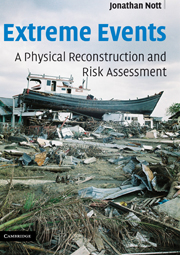1 - Introduction
Published online by Cambridge University Press: 18 December 2009
Summary
The problem with natural hazard risk assessments
There is a problem with many natural hazard risk assessments. They do not incorporate long-term and/or prehistoric records of extreme events; otherwise known as natural hazards when they affect humans physically, psychologically, socially or economically. Short historical records are frequently assumed to be a true reflection of the long-term behaviour of a hazard. Historical records may be appropriate, in this regard, where they extend for at least several centuries or even a millennium such as in China. However, in many countries, like the United States, United Kingdom and Australia, the historical record is often not much longer than 100 years. Many assessors of risks from natural hazards see these short records as appropriate for determining the natural variability of a hazard. From this they extrapolate to determine the magnitude of less frequent, higher magnitude events and construct probability distributions of the occurrence of a hazard at various return intervals. Inherent in this process is the assumption that natural hazards occur randomly over a variety of time scales and that the mean and variance of the hazard do not change. This may be true in certain circumstances, especially shorter time periods, but is often not the case for longer intervals. When we rely upon short historical records we run the real risk of not capturing the natural variability of the hazard.
- Type
- Chapter
- Information
- Extreme EventsA Physical Reconstruction and Risk Assessment, pp. 1 - 16Publisher: Cambridge University PressPrint publication year: 2006



